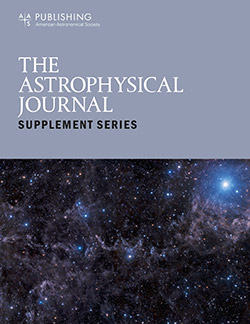Spectral Features of the Solar Transition Region and Chromospheric Lines at Flare Ribbons Observed with IRIS
IF 8.5
1区 物理与天体物理
Q1 ASTRONOMY & ASTROPHYSICS
引用次数: 1
Abstract
Abstract We report on the spectral features of the Si iv λ 1402.77, C ii λ 1334.53, and Mg ii h or k lines, formed in the layers from the transition region to the chromosphere, in three two-ribbon flares (with X, M, and C class) observed with IRIS. All three lines show significant redshifts within the main flare ribbons, which mainly originate from the chromospheric condensation during the flares. The average redshift velocities of the Si iv line within the main ribbons are 56.6, 25.6, and 10.5 km s −1 for the X-, M-, and C-class flares, respectively, which show a decreasing tendency with the flare class. The C ii and Mg ii lines show a similar tendency but with smaller velocities compared to the Si iv line. Additionally, the Mg ii h or k line shows a blue-wing enhancement in the three flares, in particular at the flare ribbon fronts, which is supposed to be caused by an upflow in the upper chromosphere due to the heating of the atmosphere. Moreover, the Mg ii h or k line exhibits a central reversal at the flare ribbons but turns to pure emission shortly after 1–4 minutes. Correspondingly, the C ii line also shows a central reversal but in a smaller region. However, for the Si iv line, the central reversal is only found in the X-class flare. As usual, the central reversal of these lines can be caused by the opacity effect. This implies that, in addition to the optically thick lines (C ii and Mg ii lines), the Si iv line can become optically thick in a strong flare, which is likely related to the nonthermal electron beam heating.用IRIS观测太阳过渡区的光谱特征和耀斑带的色球线
摘要本文报道了用IRIS观测到的3个X、M、C类双带耀斑从过渡区到色球层形成的Si λ 1402.77、cii λ 1334.53和mgii h或k谱线的光谱特征。这三条线都显示了主耀斑带内明显的红移,这主要是由耀斑期间的色球凝结引起的。X级、M级和c级耀斑的Si - iv线在主带内的平均红移速度分别为56.6、25.6和10.5 km s−1,随耀斑级别的增加,Si - iv线的平均红移速度呈减小趋势。与Si - iv线相比,C - ii线和Mg - ii线表现出类似的趋势,但速度较小。此外,mgih或k线在三个耀斑中显示出蓝翼增强,特别是在耀斑带前部,这应该是由于大气加热引起的上层色球层的上升流造成的。此外,Mg ii h或k线在耀斑带处表现出中心反转,但在1-4分钟后不久转为纯发射。相应的,C ii线也显示一个中心反转,但在一个较小的区域。然而,对于Si iv线,中心反转只在x级耀斑中发现。像往常一样,这些线条的中心反转可能是由不透明度影响引起的。这意味着,除了光学粗谱线(Cⅱ和Mgⅱ谱线)外,Siⅳ谱线在强耀斑中也会变得光学粗谱线,这可能与非热电电子束加热有关。
本文章由计算机程序翻译,如有差异,请以英文原文为准。
求助全文
约1分钟内获得全文
求助全文
来源期刊

Astrophysical Journal Supplement Series
地学天文-天文与天体物理
CiteScore
14.50
自引率
5.70%
发文量
264
审稿时长
2 months
期刊介绍:
The Astrophysical Journal Supplement (ApJS) serves as an open-access journal that publishes significant articles featuring extensive data or calculations in the field of astrophysics. It also facilitates Special Issues, presenting thematically related papers simultaneously in a single volume.
 求助内容:
求助内容: 应助结果提醒方式:
应助结果提醒方式:


